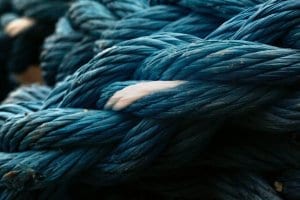The rope that you will find in the lifting gear industry today falls into two distinct categories; man-made or natural fibre. It can sometimes be hard to know which is the best one to use and when, and so we’ve put together this handy little guide on natural fibre rope slings to take the guesswork out of it for you!
The difference between man-made and natural fibre rope
Before getting into exactly when you would be best using natural fibre rope, we thought it would be important to clearly define the difference between this and the man-made variety. The latter, sometimes also referred to as synthetic, is man-made, and has been created using materials and chemicals that imitate the properties of natural fibre rope.
Typically,
man-made rope will be manufactured from materials such as polypropylene, nylon, polyethylene or polyesters. The man-made variety generally has a
longer service life than that of natural fibre rope, around 30% longer, and is more resistant to water.
 This type of product has some great qualities
This type of product has some great qualities
It is also stronger than natural products, having around a 20% stronger tensile strength than its counterpart. Finally, it won’t shrink when wet, whereas natural rope will.
So, when should you use natural fibre rope slings?
There seems like a lot of preferable positives to using man-made rope over the natural type, but there are also plenty of reasons to use the latter too! It is designed for more lightweight applications, and also to provide its user with a better grip. This makes it the safer alternative when wanting to tie knots, as synthetic products can slip easily.
Also,
natural fibre rope won’t melt at high temperatures, while synthetic will. The natural rope will only be damaged by heat if set on fire! Finally, as it is natural, it is much better for the environment than synthetic products, which are created using dangerous chemicals.
There are four main types of the natural variety, and we have detailed these below.
Cotton
This is great as it can be dyed a variety of colours. Commonly used for applications such as packaging, hanging pictures or sash cords that you’ll find on window blinds.
Jute
Mainly used for fabrics such as sacking or hessian, but can also be used for the twine and ropes that you’ll find in some contemporary stairs or boating applications. Strong nature, but rough in texture.
Sisal
A tough, durable rope. It is extremely resilient against saltwater, making it great for boating applications. Also used for architectural applications too.
Manila
Also a strong, durable product that is resistant to saltwater, and also sunlight. This makes it another highly popular type of rope within the marine industry. Alongside this, you’ll find it being used in the construction and agriculture sector.
Looking for more information on natural fibre rope slings?
As you can see, there are several types of rope. While newer synthetic rope has many benefits, there is still plenty of use for the natural type in the world today! If you would like more information on how this equipment can help you specifically, then you can get in touch with us
here.
 This type of product has some great qualities
It is also stronger than natural products, having around a 20% stronger tensile strength than its counterpart. Finally, it won’t shrink when wet, whereas natural rope will.
This type of product has some great qualities
It is also stronger than natural products, having around a 20% stronger tensile strength than its counterpart. Finally, it won’t shrink when wet, whereas natural rope will.